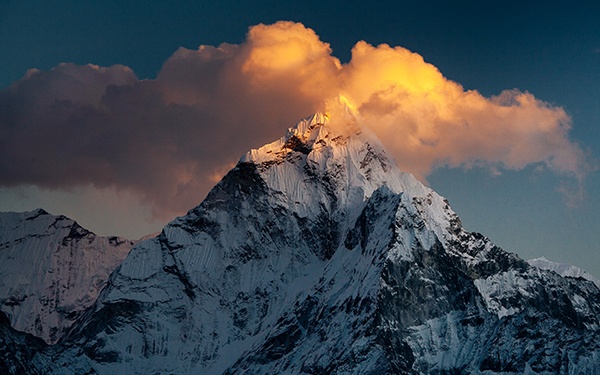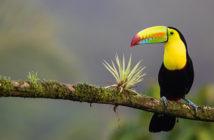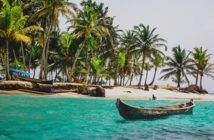Are you thinking about moving to Nepal from the UK?
Picture this: mists curl up from towering mountain peaks bathed in shades of apricot and rose coloured by the rays of the rising sun.
Monks with robes the colour of sunset wind their way through centuries old monasteries and temples.
Ancient tropical jungles alive with the chatter of exotic birds where tigers and crocodiles are king.
Frothing rivers gushing their way through yawning gorges, and brightly painted fishing boats hauling in their catch from azure waters which mirror the cloudless skies above.
A veritable heaven on earth, Nepal is all this and much, much more.
Would you like to join the many expats with their very own slice of this paradise? Read our guide to discover how you can make the dream a reality and move to Nepal…
Contents
Nepal Visa Requirements for Brits
Visiting
UK citizens require a visa to travel to Nepal. Tourist visas are valid for stays of up to 90 days and can be obtained on arrival at Tribhuvan International Airport in Kathmandu and at land border crossings that are open to foreigners.
You will need a couple of passport photos and enough US dollars to pay the visa fee, which varies from $25 to $100 depending on the intended length of your stay.
Visa extensions of up to a total length of stay of 150 days are possible, but must be applied for at the immigration offices in Kathmandu and Pokhara.
To apply you will need additional passport photos, a Nepalese street address, enough money to pay the visa extension fee, and an application form which must be completed online beforehand.
Working
Brits wanting to work in Nepal can do so in one of two ways. The first way is by applying for a non-tourist visa (aka the Nepal work visa). This can be applied for if you have entered Nepal on a regular tourist visa, is valid for 1 year, and can be extended.
The non-tourist visa is only allocated to expats working in certain domains, including working for international development organisations, as journalists for foreign newspapers and news agencies, tourist group leaders, or any other employment that has been approved by the Nepali Government. The fee for the non-tourist visa is $75 per month and it is necessary to have a job offer secured before you can apply.
The second option for Brits working in Nepal is a business visa, however this is only available to startups investing more that $50000, or UK expats investing the same sum or more in any business or industrial enterprise within Nepal or authorised representatives of such business or industrial enterprise.
The business visa costs $300 per year.
Permanent Residency
Gaining permanent residency in Nepal can be tricky.

Residential visas are available to retirees and Brits who don’t intend to work but have a regular income of at least $20000 per year, UK expats who have contributed to Nepal in a way that is recognised by the government or who are of international repute, or those who have invested a minimum lump sum of $100000 in a Nepalese industrial enterprise.
Way of Life in Nepal
Lifestyle
Nepal is a developing country which was hit hard by catastrophic earthquakes in 2015.
Despite this, it is a country which keeps moving forward and improving, and the Nepalese people retain their friendly, happy go lucky spirit.
There are nearly 70 different ethnic groups living in Nepal, most of which have their own culture, religious practices, and traditions. Namaste is the typical Nepalese greeting, which roughly translates to ‘I salute the awesome in you’.
Family is hugely important to the Nepalese, with parents, grandparents, and children often sharing the same home. Mealtimes bring family and friends together, with simple rice, vegetable, and lentil based dishes.
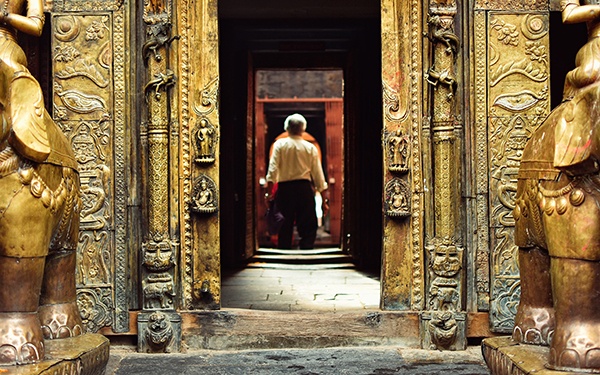
The Nepalese lifestyle is laid back, but that doesn’t mean that things are always easy. Even in the cities electricity and water shortages are common, and internet connections are not always reliable.
Sitting at the crossroads of India and China, Nepal has some of the most spectacular and unique scenery in the world, throwing open the doors to an abundance of adventurous activities for expats including trekking, white water rafting, mountaineering, paragliding, caving, kayaking, zip lining, and hang gliding, as well as exploring the wealth of cultural and historical sites the country has to offer.
Getting Around
Nepal’s terrain, road conditions, and climate can pose challenges to getting around, however there are ways around this if you are willing to be patient and think out of the box.
Buses are cheap, but very slow, are often overcrowded, and prone to breaking down — even in the case of the more luxurious express buses. Tourist buses are a better bet as they are usually in better condition and don’t take more passengers than there are seats available.
They are relatively comfortable and speedier too, but being tourist buses, they only cover routes out of Pokhara and Kathmandu to popular tourist destinations.
If you need to cover long distances quickly, Nepal has a surprisingly good choice of domestic flights, and this is a particularly useful way to travel in order to reach more remote, mountainous areas, although watch out for flights being cancelled due to bad weather, and be aware that Nepal has a fairly poor flight safety record.
Private airlines are more reliable, but command higher prices. Most flights leave from Kathmandu, and tickets can be booked through a travel agent.
In cities and towns it’s usual to get around by rickshaw, but expect to haggle for a decent fare.
Another option in Kathmandu and Pokhara is to take a taxi. Official taxis have a black numberplate and are metered. They can be hired in advance for short or long journeys, or flagged down in the street. In Kathmandu the quicker and less expensive motorbike taxis are also becoming popular.

Driving in Nepal
If you’re feeling brave, you might want to drive in Nepal — it’s a fantastic way to get to places off the beaten track quickly and in comfort, but it can sometimes be a little hair raising.
Cars and 4WD vehicles can be hired through travel agencies, and motorbikes can easily be rented in cities and bigger towns.
To rent a vehicle you’ll need an international driving permit that shows you have the right to drive either a car or motorcycle, and you’ll be expected to leave your passport with the rental agency as security. Make sure that you are covered by your insurance policy. If not it is worth taking out additional insurance to ensure that you are completely covered for any eventuality.
Nepalese drivers are a law unto themselves, and rarely take much notice of rules and regulations.
Drive with caution and remember that left turns are allowed without stopping, and that at roundabouts it is the joining traffic that has the right of way and not the vehicles already on the roundabout. Don’t expect other drivers to signal, and be aware that animals and people regularly stray out into the road unexpectedly.
Fill up on fuel whenever you can — particularly on longer journeys — as fuel shortages are common in Nepal, and even when you come across a petrol station it may well be empty.
Weather in Nepal
Nepal’s climate is largely influenced by its topography. Just like the UK, Nepal has four distinct seasons — spring from March to May, summer from June to August, autumn from September to November, and winter from December to January.
In northern Nepal the climate is colder. Summers are cool and winters can be positively bitter, whilst in the south summer temperatures can soar above 40°C and winter temperatures are mild, with lows of around 9°C and highs of around 23°C.

June through to September brings the monsoons, and rain, fog, and mist can be expected on a daily basis in mountainous areas, whilst in the lowlands there is frequent rainfall with dramatic thunderstorms which tend to break in the evening.
Cost of Living in Nepal
Lifestyle
Overall the cost of living in Nepal is very cheap. Food, alcohol, and eating out are all very affordable, although meat is a little more expensive than other groceries. Street food can cost as little as $1, and restaurant prices rarely rise above $15 per person.
Rural areas are extremely cheap and most people tend to grow their own produce. In towns and cities you can expect to live comfortably with around $100 per month to cover your expenses.
Transportation is also cheap and shouldn’t cost any more than $40 at most per month – even in the capital Kathmandu. Going to the cinema or the theatre will set you back a mere $5.
Utilities including gas, electricity, internet, and water are affordable too, costing roughly $100 on average for two people.

Rent
Rental costs in Nepal vary wildly depending on the area, but wherever you choose to live rent is vastly cheaper than in the UK.
Rural areas can be very cheap indeed, although lacking in facilities, whilst city accommodation can cost as much as $700 per month for a luxury furnished house in an expensive area, to around $220 per month for a studio apartment in a normal area.
The cheapest option for long term stay is to rent per month on a fixed term.
Here’s a look around an expat’s home in Nepal:
Healthcare
Despite having both public and private healthcare services, the standard of medical care in Nepal falls well below that of the UK.
Facilities are limited and disease and illnesses are rife in many parts of the country. Kathmandu possesses the most modern hospitals and clinics, and expats are strongly advised to take out private health insurance to gain access to the best healthcare possible, and to evacuate them out of the country in order to receive a higher standard of care in the case of a medical emergency.
Schooling
Formerly only available to the upper classes, education in Nepal has come a long way, and there are increasing numbers of both primary and secondary schools with growing class numbers and improved levels of literacy.
That said, the standard of education in Nepal is well below par when compared with the UK, and Brits living in Nepal prefer to enrol their children in one of a handful of first rate international schools in Kathmandu — at least three of which follow the UK national curriculum. Space, however, is limited, and fees can be expensive.
Popular Areas for Brits
Kathmandu

Wonderfully chaotic and infinitely charismatic Kathmandu is Nepal’s capital city. The streets and alleyways are heaving with life, and exotic sounds, sights, and smells.
This sprawling gateway to the mystical Himalayas is packed with UNESCO historical and cultural sites including temples, shrines, and palaces.
Devil may care rickshaw drivers bomb through the city traffic, taking tourists to explore Kathmandu’s fascinating Old Town, chill out in the city’s trendiest bars, or to eat in gourmet restaurants.
Kathmandu is also where you’ll find a thriving expat community and the best facilities, including schools and medical care.
Pokhara
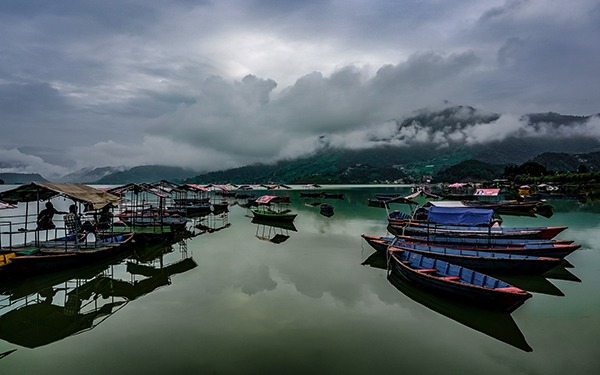
Another expat favourite, Pokhara is Nepal’s second biggest city, is a bohemian metropolis which for decades has attracted foreigners with its incredible scenery, chilled out atmosphere, and spirituality.
Situated on an intensely beautiful lake in the heart of the Himalayas and surrounded by snow dusted mountain peaks, Pokhara is also adventure central, pulling in thrill seekers from all over who use the city as a base for white water rafting, paragliding, and some of the most sensational trekking trails in the world.
Bhaktapur

Sadly the 2015 earthquakes destroyed a number of ancient temples in this medieval city, but happily a large number still remain, and they represent some of the most extraordinary architecture in Nepal.
Beautiful Bhaktapur attracts many tourists who come not only to wonder at the towering temples, but also to experience a unique glimpse of Nepalese culture practised by the many traditional artisans who live here.
Patan

Just across the river from Kathmandu, Patan is a fine mix of ancient and modern. It’s a hotspot for top notch restaurants, shops and bars, which attract both locals and a large number of expats who live in the surrounding suburbs.
This is one of the best places in Nepal to find fine, fair trade items and traditional Nepalese handicrafts. The jewel in Patan’s crown however is the stunning Durbar Square with its royal palace, wealth of ornate temples, and the Patan Museum.
Dharan
Located near the Southeastern border of India in eastern Nepal, hilly Dharan is the starting point of many breathtaking treks across the Mahabharat hills and the eastern Himalayas.
Once a Gurkha recruiting area, many ex-British army soldiers have made Dharan their home, and there’s a tangible western influence in the clean streets of this colourful and culturally diverse city.
Nuwakot
Perhaps Nepal’s best kept secret, Nuwakot is a small village on the ancient trade route between Nepal and Tibet.
Watched over by a historic abandoned fortress Nuwakot seems like a place caught between time, where villagers practice medieval traditions, and where the unique cultures of many tribes and clans can be observed.
Jobs in Nepal for British Expats

Unemployment rates in Nepal are high, and many expats living here choose to work voluntarily as finding paid work can be very difficult.
That said, for Brits with the right set of skills, there do exist a small number of employment possibilities. Nepal’s main industries are trade and export, agriculture, and tourism, and while skilled expats may perhaps find work in those sectors, they may also stand a chance of finding a job in management, engineering, administration, government, IT, finance, teaching, and aid work.
Are you moving to Nepal from the UK?

